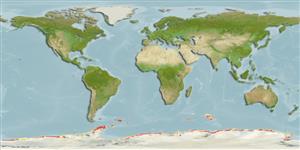Common names from other countries
Classification / Names / Names
Common names | Synonyms | Catalog of Fishes (gen., sp.) | ITIS | CoL | WoRMS
Environment: milieu / climate zone / depth range / distribution range
Ecology
Benthic; depth range 1 - 508 m (Ref. 124196). Polar; 48°S - 78°S, 170°W - 170°E
Antarctic: Antarctica.
Length at first maturity / Size / Weight / Age
Maturity: Lm ? range ? - ? cm Max length : 8.3 cm SHL male/unsexed; (Ref. 7659); max. reported age: 13 years (Ref. 8072)
Life cycle and mating behavior
Maturity | Reproduction | Spawning | Eggs | Fecundity | Larvae
Members of the class Bivalvia are mostly gonochoric, some are protandric hermaphrodites. Life cycle: Embryos develop into free-swimming trocophore larvae, succeeded by the bivalve veliger, resembling a miniature clam.
MarineSpecies.org. 2050. (Ref. 3477)
IUCN Red List Status (Ref. 130435)
CITES status (Ref. 108899)
Not Evaluated
Not Evaluated
Threat to humans
Harmless
Human uses
| FishSource |
Tools
Internet sources
Estimates based on models
Preferred temperature
(Ref.
115969): -1.8 - -0.6, mean -1.5 (based on 214 cells).
Resilience
Medium, minimum population doubling time 1.4 - 4.4 years (K=0.16; tmax=13).
Vulnerability
Moderate to high vulnerability (46 of 100).
Price category
Unknown.
